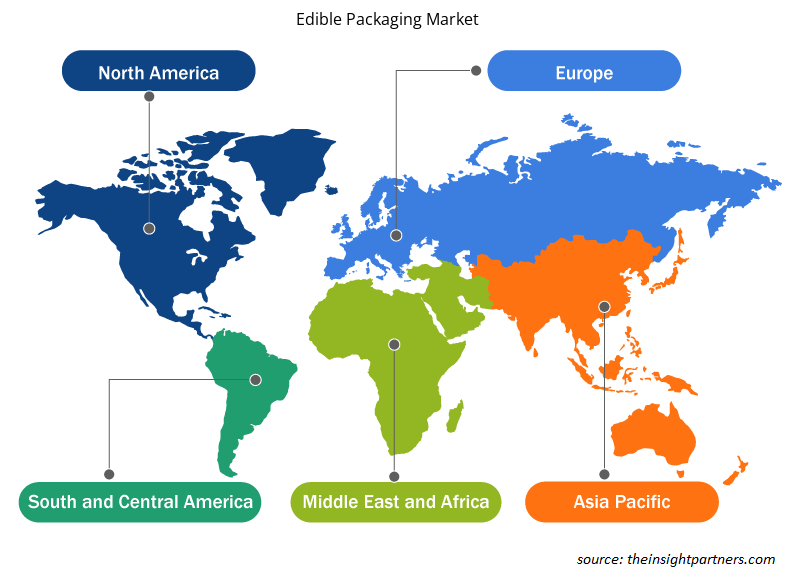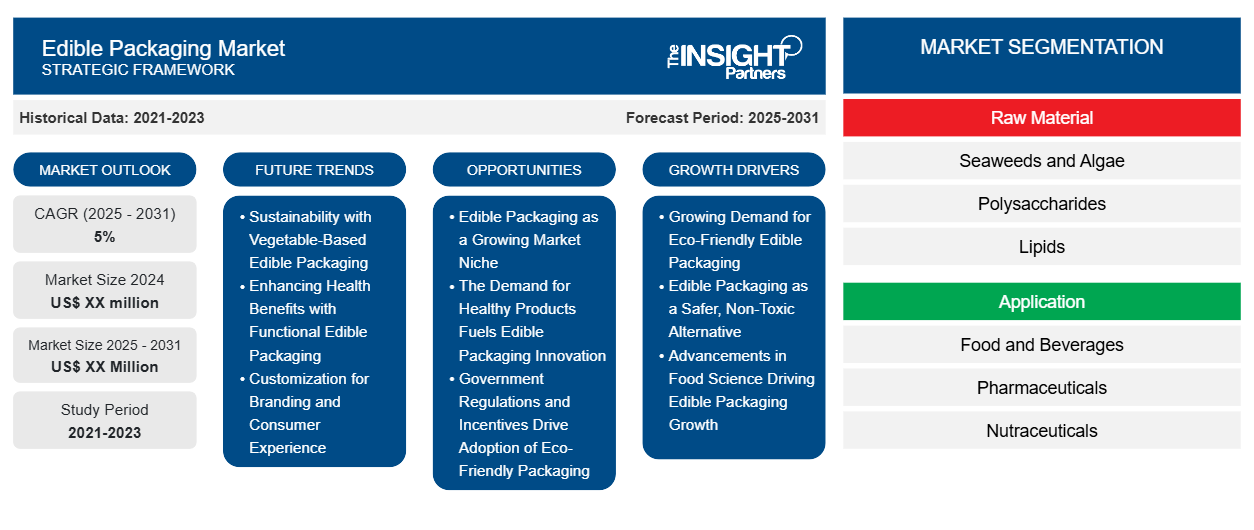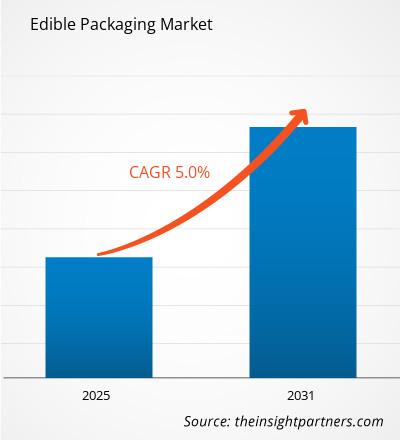Es wird erwartet, dass der Markt für essbare Verpackungen von 2023 bis 2031 eine durchschnittliche jährliche Wachstumsrate (CAGR) von 5 % verzeichnet, wobei die Marktgröße von XX Millionen US-Dollar im Jahr 2023 auf XX Millionen US-Dollar im Jahr 2031 wächst.
Der Bericht ist nach Rohstoffen (Seetang und Algen, Polysaccharide, Lipide, andere) segmentiert. Der Bericht präsentiert außerdem Analysen basierend auf der Anwendung [Lebensmittel und Getränke (Bäckerei- und Süßwaren, Getränke, Fleisch, Geflügel und Meeresfrüchteprodukte, andere), Pharmazeutika und Nutraceutika]. Die globale Analyse ist weiter auf regionaler Ebene und in den wichtigsten Ländern aufgeschlüsselt. Geografisch ist der Markt in Nordamerika, Europa, Asien-Pazifik, Naher Osten und Afrika sowie Süd- und Mittelamerika unterteilt. Der Bericht bietet den Wert in USD für die oben genannten Analysen und Segmente.
Zweck des Berichts
Der Bericht „Markt für essbare Verpackungen“ von The Insight Partners zielt darauf ab, die aktuelle Situation und das zukünftige Wachstum sowie die wichtigsten treibenden Faktoren, Herausforderungen und Chancen zu beschreiben. Dies wird verschiedenen Geschäftspartnern Einblicke geben, wie zum Beispiel:
- Technologieanbieter/-hersteller: Um die sich entwickelnde Marktdynamik zu verstehen und die potenziellen Wachstumschancen zu kennen, damit sie fundierte strategische Entscheidungen treffen können.
- Investoren: Durchführung einer umfassenden Trendanalyse hinsichtlich der Marktwachstumsrate, der finanziellen Marktprognosen und der Chancen entlang der Wertschöpfungskette.
- Regulierungsbehörden: Sie regulieren Richtlinien und polizeiliche Maßnahmen auf dem Markt mit dem Ziel, Missbrauch zu minimieren, das Vertrauen der Anleger zu bewahren und die Integrität und Stabilität des Marktes aufrechtzuerhalten.
Marktsegmentierung für essbare Verpackungen
Rohstoff
- Meerespflanzen und Algen
- Polysaccharide
- Lipide
Anwendung
- Essen und Trinken
- Pharmazeutika
- Nutrazeutika
Passen Sie diesen Bericht Ihren Anforderungen an
Sie erhalten kostenlose Anpassungen an jedem Bericht, einschließlich Teilen dieses Berichts oder einer Analyse auf Länderebene, eines Excel-Datenpakets sowie tolle Angebote und Rabatte für Start-ups und Universitäten.
- Holen Sie sich die wichtigsten Markttrends aus diesem Bericht.Dieses KOSTENLOSE Beispiel umfasst eine Datenanalyse von Markttrends bis hin zu Schätzungen und Prognosen.
Wachstumstreiber auf dem Markt für essbare Verpackungen
- Wachsende Nachfrage nach umweltfreundlichen essbaren Verpackungen: Verbraucher und Unternehmen sind heute auf der Suche nach umweltfreundlichen Alternativen zu herkömmlichen Verpackungsformen. Daher sind essbare Verpackungen eine nachhaltige Option. Sie bestehen aus natürlichen Materialien wie Seetang, Reis oder Stärke und reduzieren so die Verpackungsabfälle. Dies kann für umweltbewusste Verbraucher und Marken sehr attraktiv sein.
- Essbare Verpackungen als sicherere, ungiftige Alternative: Es gibt bereits wachsende medizinische Bedenken hinsichtlich der Herstellung von Verpackungen mit Chemikalien, was wiederum zu essbaren Verpackungen als sehr sichere und ungiftige Option geführt hat. Dies negiert die Bedenken, dass Chemikalien aus Kunststoff in Lebensmittel gelangen – genau die Einstellung der Verbraucher, gesündere, natürlichere Produkte zu bevorzugen, treibt den Markt für essbare Verpackungen auf Wachstumskurs.
- Fortschritte in der Lebensmittelwissenschaft treiben das Wachstum bei essbaren Verpackungen voran: Tatsächlich gibt es Fortschritte in der Lebensmittelwissenschaft und bei der Entwicklung neuer essbarer Verpackungsmaterialien. Diese Technologien verlängern die Haltbarkeit von essbaren Verpackungsmaterialien, verbessern ihre Funktionalität und verbessern auch den Geschmack essbarer Produkte, wodurch das Marktwachstum durch Anwendungen in vielen Lebensmittelprodukten beschleunigt wird.
Zukünftige Trends auf dem Markt für essbare Verpackungen
- Nachhaltigkeit mit essbaren Verpackungen auf pflanzlicher Basis: Der Trend zu essbaren Verpackungen geht zunehmend in Richtung der Verwendung pflanzlicher Zutaten wie Seetang, Reis und Kartoffelstärke. Diese Materialien sind äußerst nachhaltig, biologisch abbaubar und erfüllen die Anforderungen der Verbraucher an umweltfreundliche, erneuerbare und abfallreduzierende alternative Verpackungsmaterialien.
- Verbesserung des Gesundheitsnutzens durch funktionale essbare Verpackungen: Durch die Einarbeitung von Antioxidantien, Vitaminen oder Probiotika werden essbare Verpackungen mit funktionalen Lebensmitteleigenschaften ausgestattet. Diese Neuheit steigert den Gesundheitsnutzen innerhalb der Verpackung noch weiter und bietet somit einen Mehrwert für die Verbraucher und verbessert die Aussichten für Marken, innovative funktionale und zugleich nährstoffverbessernde Verpackungslösungen zu entwickeln.
- Anpassung für Branding und Verbrauchererlebnis: Da sich der Markt ständig verändert, gibt es wachsende Trends bei der Anpassung essbarer Verpackungen für Lebensmittel, um ihre visuellen und anatomischen Markenmerkmale zu erfüllen. Individuelle Formen, Farben und Designs werden immer beliebter: eine Gelegenheit für Marken, sich vom Rest abzuheben und einen Mehrwert für das Verbrauchererlebnis zu schaffen.
Marktchancen für essbare Verpackungen
- Essbare Verpackungen als wachsende Marktnische: Der Konsum essbarer Verpackungen entwickelt sich zu einer sehr vielversprechenden Marktnische, insbesondere im Lebensmittel- und Getränkebereich, was darauf schließen lässt, dass dieser Markt ein großes Wachstumspotenzial bietet. Hier kommen solche Unternehmen ins Spiel und nutzen das, was die Menschen von einer zunehmend abfallreduzierenden Lösung erwarten: eine Verpackung, die gut funktioniert, aber auch als umweltfreundlich bezeichnet werden kann.
- Die Nachfrage nach gesunden Produkten treibt Innovationen bei essbaren Verpackungen voran: Der veränderte Konsumtrend zu gesunden Produkten, zu denen Bio-Snacks, Proteingele und Nahrungsergänzungsmittel gehören, hat Möglichkeiten für essbare Verpackungen eröffnet. Sie bieten eine sehr innovative Möglichkeit, ein Produkt attraktiv zu machen und gleichzeitig die enorme Nachfrage nach natürlicheren und sichereren Lösungen zu erfüllen, ganz zu schweigen von der Nachhaltigkeit.
- Staatliche Vorschriften und Anreize fördern die Einführung umweltfreundlicher Verpackungen: Die Regierung lässt wirtschaftliche Modelle offen, die tiefgekühlte Lebensmittel ersetzen, da sie strengere Beschränkungen für marktfähige Abfälle und sogar die Verwendung von Kunststoffen im Allgemeinen erwägt. Die Einführung solcher Technologien im Zuge der aktuellen Veränderungen würde den Unternehmen durch die durch die Vorschriften gewährten Anreize Gewinne bringen, und die Kundentreue würde einen integrierten Markt für das Unternehmen schaffen, da es seine Verpackungen umweltfreundlich gestaltet.
Regionale Einblicke in den Markt für essbare Verpackungen
Die regionalen Trends und Faktoren, die den Markt für essbare Verpackungen während des gesamten Prognosezeitraums beeinflussen, wurden von den Analysten von Insight Partners ausführlich erläutert. In diesem Abschnitt werden auch Marktsegmente und Geografien für essbare Verpackungen in Nordamerika, Europa, im asiatisch-pazifischen Raum, im Nahen Osten und Afrika sowie in Süd- und Mittelamerika erörtert.

- Erhalten Sie regionale Daten zum Markt für essbare Verpackungen
Umfang des Marktberichts für essbare Verpackungen
| Berichtsattribut | Details |
|---|---|
| Marktgröße im Jahr 2023 | XX Millionen US-Dollar |
| Marktgröße bis 2031 | XX Millionen US-Dollar |
| Globale CAGR (2023 - 2031) | 5 % |
| Historische Daten | 2021-2022 |
| Prognosezeitraum | 2024–2031 |
| Abgedeckte Segmente | Nach Rohmaterial
|
| Abgedeckte Regionen und Länder | Nordamerika
|
| Marktführer und wichtige Unternehmensprofile |
|
Marktdichte von essbaren Verpackungen: Auswirkungen auf die Geschäftsdynamik verstehen
Der Markt für essbare Verpackungen wächst rasant, angetrieben durch die steigende Nachfrage der Endverbraucher aufgrund von Faktoren wie sich entwickelnden Verbraucherpräferenzen, technologischen Fortschritten und einem größeren Bewusstsein für die Vorteile des Produkts. Mit steigender Nachfrage erweitern Unternehmen ihr Angebot, entwickeln Innovationen, um die Bedürfnisse der Verbraucher zu erfüllen, und nutzen neue Trends, was das Marktwachstum weiter ankurbelt.
Die Marktteilnehmerdichte bezieht sich auf die Verteilung der Firmen oder Unternehmen, die in einem bestimmten Markt oder einer bestimmten Branche tätig sind. Sie gibt an, wie viele Wettbewerber (Marktteilnehmer) in einem bestimmten Marktraum im Verhältnis zu seiner Größe oder seinem gesamten Marktwert präsent sind.
Die wichtigsten auf dem Markt für essbare Verpackungen tätigen Unternehmen sind:
- Avani Öko
- Devro PLC
- Envi Green Biotech Pvt Ltd
- Evoware
- Unglaubliche Lebensmittel Inc.
Haftungsausschluss : Die oben aufgeführten Unternehmen sind nicht in einer bestimmten Reihenfolge aufgeführt.

- Überblick über die wichtigsten Akteure auf dem Markt für essbare Verpackungen
Wichtige Verkaufsargumente
- Umfassende Abdeckung: Der Bericht deckt die Analyse von Produkten, Dienstleistungen, Typen und Endbenutzern des Marktes für essbare Verpackungen umfassend ab und bietet einen ganzheitlichen Überblick.
- Expertenanalyse: Der Bericht basiert auf dem umfassenden Verständnis von Branchenexperten und Analysten.
- Aktuelle Informationen: Der Bericht stellt durch die Abdeckung aktueller Informationen und Datentrends Geschäftsrelevanz sicher.
- Anpassungsoptionen: Dieser Bericht kann angepasst werden, um spezifische Kundenanforderungen zu erfüllen und die Geschäftsstrategien optimal anzupassen.
Der Forschungsbericht zum Markt für essbare Verpackungen kann daher dabei helfen, die Branchensituation und Wachstumsaussichten zu entschlüsseln und zu verstehen. Obwohl es einige berechtigte Bedenken geben kann, überwiegen die allgemeinen Vorteile dieses Berichts tendenziell die Nachteile.
- Historische Analyse (2 Jahre), Basisjahr, Prognose (7 Jahre) mit CAGR
- PEST- und SWOT-Analyse
- Marktgröße Wert/Volumen – Global, Regional, Land
- Branche und Wettbewerbsumfeld
- Excel-Datensatz



Report Coverage
Revenue forecast, Company Analysis, Industry landscape, Growth factors, and Trends

Segment Covered
This text is related
to segments covered.

Regional Scope
North America, Europe, Asia Pacific, Middle East & Africa, South & Central America

Country Scope
This text is related
to country scope.
Häufig gestellte Fragen
The report can be delivered in PDF/Word format, we can also share excel data sheet based on request.
Based on geography, North America held the largest share of the edible packaging market.
Avani Eco, Devro PLC, Envi Green Biotech Pvt Ltd, Evoware, Incredible Foods Inc., JRF Technology, LLC, Monosol LLC, Nagase America LLC., Notpla Limited are the key players operating in the edible packaging market.
On the basis of geography, theedible packaging market is classified into North America, Europe, Asia Pacific, Middle East and Africa, and South and Central America.
Edible packaging, made from natural materials like seaweed, rice, or starch, offers a sustainable option that reduces waste, making it an attractive choice for environmentally-conscious consumers and brands. Which is driving the growth of the edible packaging market.
The Edible Packaging Market is estimated to witness a CAGR of 5% from 2023 to 2031
Trends and growth analysis reports related to Chemicals and Materials : READ MORE..
1. Avani Eco
2. Devro PLC
3. Envi Green Biotech Pvt Ltd
4. Evoware
5. Incredible Foods Inc.
6. JRF Technology, LLC
7. Monosol LLC
8. Nagase America LLC.
9. Notpla Limited
10. Tipa Corp
The Insight Partners performs research in 4 major stages: Data Collection & Secondary Research, Primary Research, Data Analysis and Data Triangulation & Final Review.
- Data Collection and Secondary Research:
As a market research and consulting firm operating from a decade, we have published and advised several client across the globe. First step for any study will start with an assessment of currently available data and insights from existing reports. Further, historical and current market information is collected from Investor Presentations, Annual Reports, SEC Filings, etc., and other information related to company’s performance and market positioning are gathered from Paid Databases (Factiva, Hoovers, and Reuters) and various other publications available in public domain.
Several associations trade associates, technical forums, institutes, societies and organization are accessed to gain technical as well as market related insights through their publications such as research papers, blogs and press releases related to the studies are referred to get cues about the market. Further, white papers, journals, magazines, and other news articles published in last 3 years are scrutinized and analyzed to understand the current market trends.
- Primary Research:
The primarily interview analysis comprise of data obtained from industry participants interview and answers to survey questions gathered by in-house primary team.
For primary research, interviews are conducted with industry experts/CEOs/Marketing Managers/VPs/Subject Matter Experts from both demand and supply side to get a 360-degree view of the market. The primary team conducts several interviews based on the complexity of the markets to understand the various market trends and dynamics which makes research more credible and precise.
A typical research interview fulfils the following functions:
- Provides first-hand information on the market size, market trends, growth trends, competitive landscape, and outlook
- Validates and strengthens in-house secondary research findings
- Develops the analysis team’s expertise and market understanding
Primary research involves email interactions and telephone interviews for each market, category, segment, and sub-segment across geographies. The participants who typically take part in such a process include, but are not limited to:
- Industry participants: VPs, business development managers, market intelligence managers and national sales managers
- Outside experts: Valuation experts, research analysts and key opinion leaders specializing in the electronics and semiconductor industry.
Below is the breakup of our primary respondents by company, designation, and region:

Once we receive the confirmation from primary research sources or primary respondents, we finalize the base year market estimation and forecast the data as per the macroeconomic and microeconomic factors assessed during data collection.
- Data Analysis:
Once data is validated through both secondary as well as primary respondents, we finalize the market estimations by hypothesis formulation and factor analysis at regional and country level.
- Macro-Economic Factor Analysis:
We analyse macroeconomic indicators such the gross domestic product (GDP), increase in the demand for goods and services across industries, technological advancement, regional economic growth, governmental policies, the influence of COVID-19, PEST analysis, and other aspects. This analysis aids in setting benchmarks for various nations/regions and approximating market splits. Additionally, the general trend of the aforementioned components aid in determining the market's development possibilities.
- Country Level Data:
Various factors that are especially aligned to the country are taken into account to determine the market size for a certain area and country, including the presence of vendors, such as headquarters and offices, the country's GDP, demand patterns, and industry growth. To comprehend the market dynamics for the nation, a number of growth variables, inhibitors, application areas, and current market trends are researched. The aforementioned elements aid in determining the country's overall market's growth potential.
- Company Profile:
The “Table of Contents” is formulated by listing and analyzing more than 25 - 30 companies operating in the market ecosystem across geographies. However, we profile only 10 companies as a standard practice in our syndicate reports. These 10 companies comprise leading, emerging, and regional players. Nonetheless, our analysis is not restricted to the 10 listed companies, we also analyze other companies present in the market to develop a holistic view and understand the prevailing trends. The “Company Profiles” section in the report covers key facts, business description, products & services, financial information, SWOT analysis, and key developments. The financial information presented is extracted from the annual reports and official documents of the publicly listed companies. Upon collecting the information for the sections of respective companies, we verify them via various primary sources and then compile the data in respective company profiles. The company level information helps us in deriving the base number as well as in forecasting the market size.
- Developing Base Number:
Aggregation of sales statistics (2020-2022) and macro-economic factor, and other secondary and primary research insights are utilized to arrive at base number and related market shares for 2022. The data gaps are identified in this step and relevant market data is analyzed, collected from paid primary interviews or databases. On finalizing the base year market size, forecasts are developed on the basis of macro-economic, industry and market growth factors and company level analysis.
- Data Triangulation and Final Review:
The market findings and base year market size calculations are validated from supply as well as demand side. Demand side validations are based on macro-economic factor analysis and benchmarks for respective regions and countries. In case of supply side validations, revenues of major companies are estimated (in case not available) based on industry benchmark, approximate number of employees, product portfolio, and primary interviews revenues are gathered. Further revenue from target product/service segment is assessed to avoid overshooting of market statistics. In case of heavy deviations between supply and demand side values, all thes steps are repeated to achieve synchronization.
We follow an iterative model, wherein we share our research findings with Subject Matter Experts (SME’s) and Key Opinion Leaders (KOLs) until consensus view of the market is not formulated – this model negates any drastic deviation in the opinions of experts. Only validated and universally acceptable research findings are quoted in our reports.
We have important check points that we use to validate our research findings – which we call – data triangulation, where we validate the information, we generate from secondary sources with primary interviews and then we re-validate with our internal data bases and Subject matter experts. This comprehensive model enables us to deliver high quality, reliable data in shortest possible time.


 Holen Sie sich ein kostenloses Muster für diesen Bericht
Holen Sie sich ein kostenloses Muster für diesen Bericht